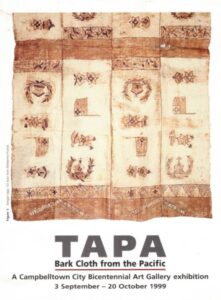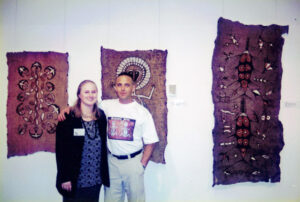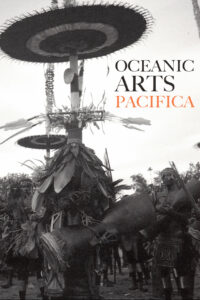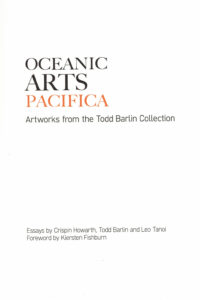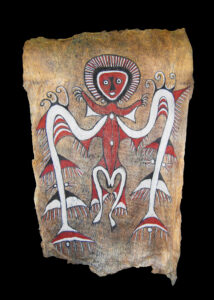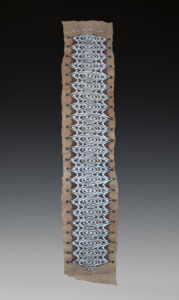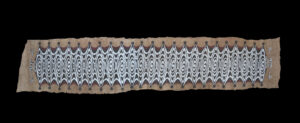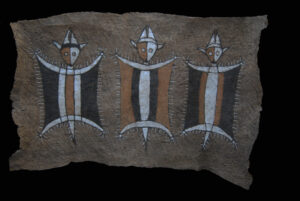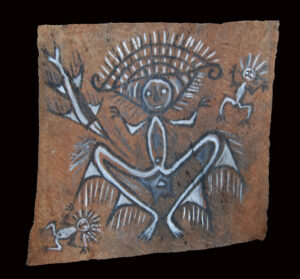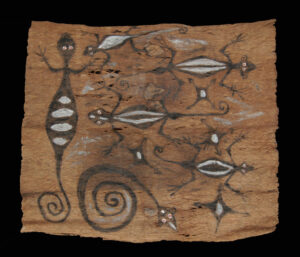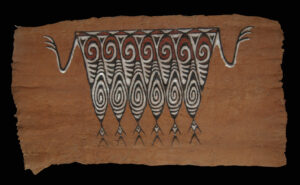Exhibition: TAPA BARK CLOTH FROM THE PACIFIC at Campbelltown City Art Gallery Sydney 1999
| Collection No. | TAPA BARK CLOTH FROM THE PACIFIC |
|---|---|
| Size |
TAPA: BARK CLOTH FROM THE PACIFIC at the Campbelltown City Art Gallery, Sydney Australia 1999
This superb exhibition showcased Tapa Cloth from the Pacific Islands curated by Greta North & Tom Gilbert at The Campbelltown City Art Gallery and it had a big display of Tapa Paintings from Lake Sentani and Humboldt Bay area from the Todd Barlin Collection & a contribution of the essay for the exhibition booklet (below)
Tapa Cloth Paintings from Lake Sentani & Humboldt Bay area of West Papua by Todd Barlin 1999
The appreciation of indigenous art has come a long way in the past ten years, indigenous artists from around the world have benefited from the interest in their cultural heritage and visual arts. This is certainly the case with the Tapa Cloth Paintings from Northwest Irian Jaya or West Papua
Tapa Cloth Paintings from Lake Sentani & Humboldt Bay in NW Irian Jaya are locally known are Maro Smo. Early accounts of local people making and wearing decorated Tapa cloth are sketchy, but it seems that married women did wear Tapa Cloth Skirts with were sometimes decorated with designs.
An early 20th-century photograph by the ethnographer Paul Wirtz in 1926 shows a large painted Tapa Cloth displayed next to a grave of young women (published in the book The Art of Northwest New Guinea by Suzanne Greub 1992 page 130 shows this early Paul Wirtz photo)
The Tapa Cloth paintings that the outside world associates with Lake Sentani & Humboldt Bay were mainly collected in the late 1920s by Jacques Viot, the French surrealist author & art dealer who made a trip to the area in 1929 and collected a number of Tapa Cloth Paintings along with the more famous wood sculptures from Lake Sentani (one of the most famous sculptures from Viot’s trip to New Guinea is the double Lake Sentani Figure now in the National Gallery of Australia in Canberra)
These works of art had a great impact on the Parisian Art scene when exhibited in Paris on his return, especially on the surrealist artists like Joan Miro.
By the mid-1920s, artists active in Paris held a fascination with objects created in tribal communities in the Pacific. In their search for art beyond the real, surrealists turned to sculptures that came from the dreams and imaginations of Pacific Islanders, who were themselves considered exotic
From World War 1 through to the 1950s, it seems that the practice of making decorated Tapa Cloth largely died out. In the 1970s however European interest brought about a revival of Tapa Painting, this stimulus was essential to the continuity of the art and its progression.
Many of the design elements in these more contemporary Tapa Cloths are ancient traditional designs that belonged to specific clans & chiefly families.
One of the main Lake Sentani motifs is called Fouw, an interlocking spiral design that is said to represent eternity and is associated with to power of the chief. The Fouw designs are commonly used on many types of traditional carved wood objects including women’s canoe paddles, food bowls & plates, and house posts that are all related to chiefly families & clans.
Other common designs are stylized totemic animals, birds & fish that are all plentiful in their natural environment. There are also depictions of powerful mythological spirits that inhabit the lake, bush & ocean.
The artists in Lake Sentani & Humboldt Bay have recently received some positive results from their artistic endeavors, they have had several exhibitions and articles have been written about their art of Tapa Cloth Painting and its revival. Consequently, this interest in their art has meant sales of their Tapa Cloth Paintings to international buyers which has brought prestige and economic benefits to the artists and their communities. The best Tapa Cloth Painters some are represented in this exhibition are very pleased with the recognition and the financial rewards they have received.
One of the most beneficial aspects of the revival of this ancient art form is that is has given strong cultural symbolism for all of the Melanesian people in West Papua, this is a time of great changes in West Papua as there is a great influx of non-Melanesian people perhaps leading to them being a minority in their own traditional land. Whenever West Papuans see one of their traditional designs it reinforces a feeling of their unique cultural identity.
The people of Lake Sentani & Humboldt Bay would feel a great sense of pride in their inclusion of this exhibition of Pacific Tapa Cloth.
May 2023 post note: 24 years after this exhibition, though I have not been back to the Lake Sentani area for 2 decades I have seen some recent Tapa Cloth Paintings from the area, they seem to be less spontaneous and a bit more rigid. There was a flowering of artistic inspiration for Tapa Cloth Paintings in the 1970s & 1980s but some of the older artists would have passed away and like all over the world often younger people are not as interested in their traditional art.

